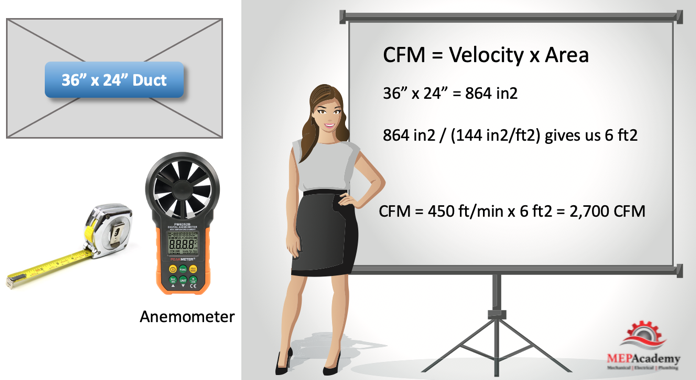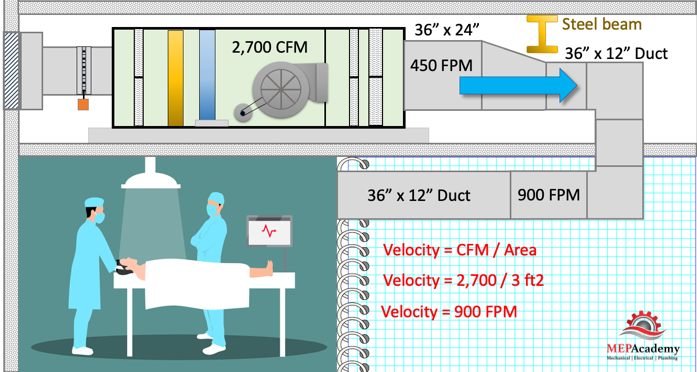In this presentation we’ll learn how to calculate the Total CFM in a section of ductwork or moving across a coil or other piece of equipment. Then we’ll learn what happens to velocity when we try to reduce our ductwork without reducing or CFM.
If you prefer to watch the YouTube Video of this presentation, scroll to the bottom or click the following link. Calculating CFM Video
Here is the formula that is used to calculate CFM or Velocity.
CFM = Velocity x Area
CFM, which is “Cubic Feet per Minute” = Velocity which is shown in “Feet per Minute” multiplied by the Area which is shown in “Square Feet.”
A cubic feet of air is a slice of air one foot by one foot, by one foot deep, which might look like this cube.
For example, to determine how many CFM were flowing through a duct section we can do the following. First we would measure the width and height of the duct. Let’s say it was 36” x 24”. Next, we could use some form of anemometer to get an average velocity reading across the duct section. Let’s say the velocity reading is 450 feet per minute. Now we can solve for the quantity of CFM flowing through this section of ductwork using the following formula.
CFM = 450 ft/min x the area, which is 36” x 24”
We’ll need to convert our duct dimensions in inches, into square feet, because we are looking to arrive at cubic feet per minute.
36” x 24” = 864 in2
864 in2 / (144 in2/ft2) gives us 6 ft2

Now we can enter the total square feet into our formula.
CFM = 450 ft/min x 6 ft2 = 2,700 CFM
Now we can use another version of this formula to calculate for velocity when the CFM and Area are known.
Solving for Velocity
For recommended velocities in ductwork see ASHRAE’s handbook of Fundamentals. Depending on the noise criteria and where the duct is located the velocity for rectangular duct could be from 950 to 3,500 feet per minute.

What happens to the velocity if you reduce the size of the ductwork with the same CFM. Let’s say that we reduce the ductwork to 36” x 12” in order to get under a beam. The approximate velocity can be calculated with the same formula, except this time will keep the CFM constant and not worry about static pressure or other factors that may affect the outcome slightly.
Velocity = CFM (ft3) / Area (ft2)
Taking the known values of 2,700 CFM and the new duct area of 36” x 12” we can find the new velocity. First the duct area needs to be converted to square feet.
36” x 12” = 432” in2
432 in2 / (144 in2/ft2) = 3 ft2

The new duct is half the area of the previous duct size, but it is carrying the same CFM. So, what happens to the velocity going through the reduced duct size in relationship to the previous velocity. Our velocity was at 450 feet per minute, now with the same CFM but a smaller duct we get 900 feet per minute.
Velocity = 2,700 CFM / 3 ft2 = 900 FPM
The ductwork area was cut in half from 6 ft2 to 3 ft2, but the velocity doubled from 450 FPM to 900 FPM. You can see there is a direct correlation between CFM and Velocity when the size of the duct or coil is changed.







